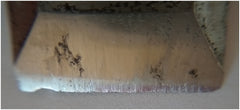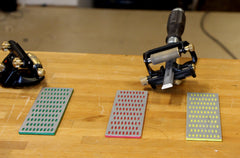Why make an already challenging job even more difficult for yourself than by doing it with boring tools? In this text, I will try to tell and show briefly how to sharpen, for example, the blade of a hand plane or a wood chisel . However, do not go into too much detail, for example with the materials of the blades or metal alloys, so that the text does not become too woody.

Attached is a close-up of a dull wood chisel blade
Before long, the wood, the resins contained in the wood, the oils or simply an awkward grain pattern dull the blades of woodworking tools. Working with a dull tool makes the cut mark jagged and can even be a work safety risk in the worst case. That's why I warmly encourage all hobbyists and why not professionals to take over blade sharpening now at the latest.
For sharpening, in addition to the blade to be sharpened, you need a whetstone or sharpener , a sharpening support that holds the blade at the right angle. In addition, you need a straight plane or surface and, if necessary, some very fine (e.g. P1500) sandpaper.
Wood chisel, three grinding stones of different grits and a sharpening guide
The sharpening angle of the cleaning plane in our example case is 25 degrees. You can easily measure the sharpening angle yourself with a protractor, for example. Once the sharpening angle has been selected, the sharpening support is adjusted and the blade is installed on it. The main purpose of the sharpening support is to keep the blade in place at the desired angle throughout the sharpening process. You can therefore easily make a suitable sharpening support from, for example, a block of wood, to which the blade can be firmly attached, and which keeps the blade angle correct. However, if you plan or use chisels a lot, it makes sense to invest in some kind of adjustable sharpening support.
Chisel sharpening, the blade is rolled back and forth on a grinding stone
Once the blade is in place, start sharpening. The blade must not be pressed against the grinding stone or diamond when it is blue, but very lightly. If the blade is very dull, it is recommended to use a rough surface when sharpening. If, on the other hand, the blade has deep notches or ridges, it may be worthwhile to straighten the blade at first, for example with emery or an angle grinder. The blade is rolled back and forth on the surface of the whetstone, and the progress of the sharpening is monitored. When the desired sharpness has been achieved, the eaves on the straight side can still be rubbed laterally with a flat surface and fine sandpaper.

Sharpened wood chisel blade
Like so. The sharp and freshly sharpened blade is also a joy to the eye!
PS The tip of a paring knife can be conveniently sharpened by cutting off one piece. The blade itself can also be slightly sharpened, for example, on the bottom of a coffee cup if it has an unglazed ring.
An easy way to cut off the tip of a serrated knife


